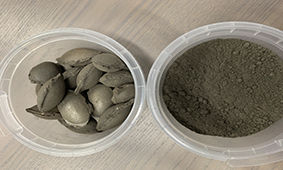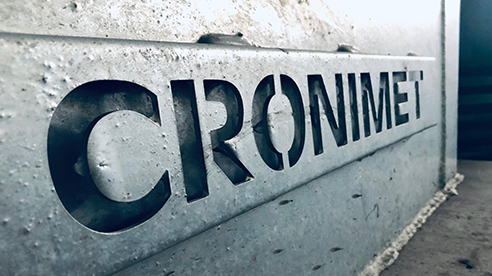
Innovative recycling of foundry waste

With the help of new technologies, metal-bearing dust, grinding sludges and mill scale can be returned to the production cycle again. Cronimet Envirotec recovers metal residues from hazardous & non-hazardous waste via vacuum distillation and briquetting.
Every day, large quantities of waste are generated in various foundry processes and in the post-processing or further treatment of metals. Cronimet Envirotec enables the return of foundry waste such as grinding sludges, mill scale, filter dust and metal powders to the production cycle. Waste liable to monitoring and in need of disposal is turned into raw materials which can then be used for metal production in foundries again.
Materials containing oil and water are processed using innovative vacuum distillation technology. For example, grinding sludge declared as hazardous waste is dried and de-oiled. Due to the vacuum no oxidation occurs, the material's quality is maintained. The process output is distilled water, oil, and metal powder. One advantage of the treatment presents the removal of all volatile contaminations, often caused by the oil so that the metals can be recovered and actually remelted. Furthermore, the hazardousness of the waste and the associated liability for the respective production sites can usually be eliminated via vacuum distillation.
The distillation plant can be attached to a briquetting facility, into which discharged powders will enter directly in order to produce almond-shaped briquettes with binder content of less than 5%. Filter dust and other fine particles can also be briquetted sepreately without the process of vacuum distillation before. Other technologies often use a high proportion of non-metallic binder, which can have a negative influence on the quality of the raw materials. During the whole process the briquettes remain metallic, rather than emerging as an oxide. Consequently the foundry purchasers of the recycled metal do not need to have a reduction process, but can melt the metal directly. It can be handled similarly to solid scrap and results in a higher yield and less slag in the smelter in comparison to the direct recirculation of powders.
For foundries, these innovative recycling methods can add great value. Hazardous waste is turned into high-quality raw materials, either as toll treatment or as a disposal service. The treatment and resulting usability of the metal powders or briquettes represent a cost advantage compared to the extraction of primary raw materials from ores. If sludges and specks of dust with a high alloy content are processed, it is furthermore possible to turn previous disposal cost into profit. In addition to saving energy and resources in comparison to mining primary resources, the described recycling also helps to minimize CO2 emissions and landfill space. This reduces waste balances and increases sustainability overall.



Trump weighs using $2 billion in CHIPS Act funding for critical minerals

Codelco cuts 2025 copper forecast after El Teniente mine collapse

Electra converts debt, launches $30M raise to jumpstart stalled cobalt refinery

Barrick’s Reko Diq in line for $410M ADB backing

Abcourt readies Sleeping Giant mill to pour first gold since 2014

Nevada army depot to serve as base for first US strategic minerals stockpile

SQM boosts lithium supply plans as prices flick higher

Viridis unveils 200Mt initial reserve for Brazil rare earth project

Tailings could meet much of US critical mineral demand – study

Kyrgyzstan kicks off underground gold mining at Kumtor

Kyrgyzstan kicks off underground gold mining at Kumtor

KoBold Metals granted lithium exploration rights in Congo

Freeport Indonesia to wrap up Gresik plant repairs by early September

Energy Fuels soars on Vulcan Elements partnership

Northern Dynasty sticks to proposal in battle to lift Pebble mine veto

Giustra-backed mining firm teams up with informal miners in Colombia

Critical Metals signs agreement to supply rare earth to US government-funded facility

China extends rare earth controls to imported material

Galan Lithium proceeds with $13M financing for Argentina project

Kyrgyzstan kicks off underground gold mining at Kumtor

Freeport Indonesia to wrap up Gresik plant repairs by early September

Energy Fuels soars on Vulcan Elements partnership

Northern Dynasty sticks to proposal in battle to lift Pebble mine veto

Giustra-backed mining firm teams up with informal miners in Colombia

Critical Metals signs agreement to supply rare earth to US government-funded facility

China extends rare earth controls to imported material

Galan Lithium proceeds with $13M financing for Argentina project

Silver price touches $39 as market weighs rate cut outlook

















